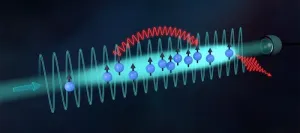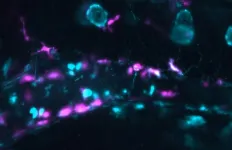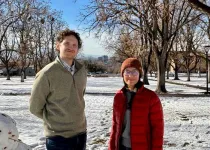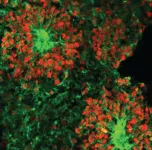(Press-News.org) AGU press contact:
Liza Lester, +1 (202) 777-7494, news@agu.org (UTC-5 hours)
Researcher contact:
Victoria Donovan, University of Florida, victoria.donovan@ufl.edu (UTC-5 hours)
WASHINGTON — The eastern U.S. has more trees and shrubs than three decades ago. This growth, driven by processes such as tree and understory infilling in unmanaged forests, is helping fuel wildfires, contributing to changing fire regimes in the eastern half of the country, according to a new study.
Some parts of the eastern and southeastern United States have experienced a tenfold increase in the frequency of large wildfires over the last forty years, with Texas and the Appalachians seeing the largest increase. However, the Northeast lacked a tie between woody plant growth and large wildfires.
Wildfires thrive on woody vegetation such as trees and shrubs. The new analysis of wildfire and vegetation data shows that the eastern U.S. has seen a 37% increase in woody cover over the last 30 years. In some regions, high levels of woody cover are linked directly to a higher risk of large wildfires over the same period.
The research “is helping us narrow in on regional drivers and focus our efforts to preemptively get ahead of the growing wildfire problem here in the eastern U.S.,” said Victoria Donovan, a landscape ecologist at the University of Florida who was the senior author on the study.
The study was published in Geophysical Research Letters, an open-access AGU journal that publishes high-impact, short-format reports with immediate implications spanning all Earth and space sciences.
Research has shown that woody cover growing in new places or thickening within forests is directly linked to increased wildfire risk in western and central parts of the country. But whether this is true out East has yet to be explored.
To test this, Donovan and her graduate student Michaella Ivey collected data on all wildfires between 1991 and 2021 that were at least 200 hectares — around 500 football fields — or larger in eastern states. They then looked where trees and shrubs were growing in the eastern U.S over the same period. To determine if woody cover influenced wildfire risk, the researchers compared the amount of woody cover within wildfire perimeters to what would be expected if wildfires were distributed at random.
The analysis revealed a strong link between woody cover and large wildfire occurrence — but only in some parts of the country. Across the eastern temperate forest, a region that makes up nearly half of the United States, each 1% increase in woody cover led to an overall 3.9% increase in the odds of a wildfire the next year. The link between woody cover and wildfire risk was strongest in eastern Texas and in and around the Appalachian Mountains.
However, the researchers found no link between woody cover and wildfire risk in the Northeast and across some parts of the Mississippi River valley. This finding “prompts all sorts of questions about what other factors are influencing the system,” Ivey said.
Cooler and wetter conditions in the Northeast, and to some extent the Mississippi River valley, may create conditions less conducive to wildfire. However, many Northeastern ecoregions could not be included in the study due to a low number of wildfires that were large enough to meet the study’s size requirements. Wildfires in these areas may stay small because of agricultural fragmentation, the researchers said.
Because woody vegetation wasn’t tied to wildfire increase consistently throughout the study area, climate change, human actions, or a combination of the two could be more important for wildfires than vegetation in some places. But overall, the research suggests that reducing fuels is a good tactic for reducing wildfire risk in the east, Donovan said.
More prescribed fires may be necessary in southern states as climate change is expected to make the southeast drier, and potentially more prone to wildfires, the researchers caution. This research shows a path forward for states and individuals to help reduce wildfire risk in the future.
“Using fuel management to reduce wildfire risk is a lot more actionable than changing the climate pattern in the short term,” Donovan said, “though addressing climate change will likely be crucial for reducing wildfire risk in the east in the long term.”
Notes for Journalists:
This study was published in Geophysical Research Letters, an open-access AGU journal. Neither this press release nor the study is under embargo. View and download a pdf of the study.
Paper title:
Woody Cover Fuels Large Wildfire Risk in the Eastern US
Authors:
Michaella A. Ivey, Carissa L. Wonkka, Noah C. Weidig, and Victoria M. Donovan (corresponding author), West Florida Research and Education Center, School of Forest, Fisheries and Geomatic Sciences, Institute of Food and Agricultural Sciences, University of Florida, Milton, FL, USA
AGU (www.agu.org) is a global community supporting more than half a million advocates and professionals in Earth and space sciences. Through broad and inclusive partnerships, AGU aims to advance discovery and solution science that accelerate knowledge and create solutions that are ethical, unbiased and respectful of communities and their values. Our programs include serving as a scholarly publisher, convening virtual and in-person events and providing career support. We live our values in everything we do, such as our net zero energy renovated building in Washington, D.C. and our Ethics and Equity Center, which fosters a diverse and inclusive geoscience community to ensure responsible conduct.
END
Wildfire surges in East, Southeast US fueled by new trees and shrubs
Woody vegetation has increased by 37% over the last 30 years in the eastern United States, fueling the rise in large wildfires. Texas and the Appalachian Mountains took the biggest hits
2024-12-18
ELSE PRESS RELEASES FROM THIS DATE:
No cavity, no party: Free-space atoms give superradiant transition a pass
2024-12-18
Isolated atoms in free space radiate energy at their own individual pace. However, atoms in an optical cavity interact with the photons bouncing back and forth from the cavity mirrors, and by doing so, they coordinate their photon emission and radiate collectively, all in sync. This enhanced light emission before all the atoms reach the ground state is known as superradiance. Interestingly, if an external laser is used to excite the atoms inside the cavity moderately, the absorption of light by the atoms and the collective emission can ...
Women often told that severity of medical abortion pain no worse than period cramps
2024-12-18
Women opting for a medical abortion at home are often advised that the procedure is likely to be no more painful than period cramps, suggest the results of a survey, carried out by the British Pregnancy Advisory Service (BPAS), and published online in the journal BMJ Sexual & Reproductive Health.
This leaves many women unprepared for the intensity of the pain they experience, with some survey respondents saying they would have chosen a different option, had they known.
More realistic and patient centred information needs to be provided to enable women to make ...
Air pollution linked to increased hospital admissions for mental/physical illness
2024-12-18
Cumulative exposure to air pollution over several years is linked to a heightened risk of admission to hospital for mental/behavioural and physical illness, finds Scottish research published in the open access journal BMJ Open.
Stricter environmental restrictions are needed to curb the impact on secondary care, conclude the researchers.
Previously published research on the health effects of long term exposure to ambient air pollution has tended to emphasise deaths rather than hospital admissions, and physical, rather than mental, ill ...
Using drones, UH researchers assess the health of humpback whale mother-calf pairs across the Pacific Ocean
2024-12-17
In a groundbreaking study published this week in The Journal of Physiology, biologists at the Marine Mammal Research Program (MMRP) at the University of Hawaiʻi at Manoa Hawaiʻi Institute of Marine Biology (HIMB) used drone imagery to advance understanding of how lactating humpback whales and their calves fare as they traverse the Pacific Ocean. Recent declines in North Pacific humpback whale reproduction and survival of calves highlight an urgent need to understand how mother-calf pairs expend energy across their migratory ...
Allen Institute names Julie Harris, Ph.D., as new Vice President of The Paul G. Allen Frontiers Group
2024-12-17
SEATTLE, WASH.—December 17, 2024—The Allen Institute today announced the appointment of Julie Harris as the new Vice President of The Paul G. Allen Frontiers Group. Harris was previously Executive Vice President of Research Management at the Cure Alzheimer’s Fund where she oversaw the funding strategy and research priorities for a ~$29 million grant portfolio in support of the most promising science and scientists working to end the burden of Alzheimer’s disease.
Between 2011 and 2020 Harris worked at the Allen Institute for Brain Science as ...
Bad bacteria can trigger painful gut contractions; new research shows how
2024-12-17
Downloadable assets for media use:
https://uoregon.canto.com/b/MSHJ8
EUGENE, Ore. — Dec. 18, 2024 — After a meal of questionable seafood or a few sips of contaminated water, bad bacteria can send your digestive tract into overdrive. Your intestines spasm and contract, efficiently expelling everything in the gut — poop and bacteria alike.
A new study from the University of Oregon shows how one kind of bacteria, Vibrio cholerae, triggers those painful contractions by activating the immune system. The research also finds a more general explanation for how the gut rids itself of unwanted intruders, which could also help scientists ...
Partnership advances targeted therapies for blood cancers
2024-12-17
Huntsman Cancer Institute at the University of Utah (the U) has joined other institutions in an innovative clinical trials program designed to match patients with acute myeloid leukemia (AML) and myelodysplastic syndromes (MDS) with a clinical trial specifically designed for the genetic signature of their disease. Sponsored by the National Cancer Institute (NCI), the myeloMATCH program aims to improve precision medicine, the use of therapies ...
How loss of urban trees affects education outcomes
2024-12-17
It’s well established that urban tree cover provides numerous environmental and psychological benefits to city dwellers. Urban trees may also bolster education outcomes and their loss could disproportionately affect students from low-income families, according to new research by University of Utah social scientists.
Economics professor Alberto Garcia looked at changes in school attendance and standardized test scores at schools in the Chicago metropolitan region over the decade after a non-native ...
New virtual reality-tested system shows promise in aiding navigation of people with blindness or low vision
2024-12-17
A new study offers hope for people who are blind or have low vision (pBLV) through an innovative navigation system that was tested using virtual reality. The system, which combines vibrational and sound feedback, aims to help users navigate complex real-world environments more safely and effectively.
The research from NYU Tandon School of Engineering, published in JMIR Rehabilitation and Assistive Technology, advances work from John-Ross Rizzo, Maurizio Porfiri and colleagues toward developing a first-of-its-kind ...
Brain cells remain healthy after a month on the International Space Station, but mature faster than brain cells on Earth
2024-12-17
LA JOLLA, CA—Microgravity is known to alter the muscles, bones, the immune system and cognition, but little is known about its specific impact on the brain. To discover how brain cells respond to microgravity, Scripps Research scientists, in collaboration with the New York Stem Cell Foundation, sent tiny clumps of stem-cell derived brain cells called “organoids” to the International Space Station (ISS).
Surprisingly, the organoids were still healthy when they returned from orbit a month later, but the cells had matured faster compared ...
LAST 30 PRESS RELEASES:
Empress cicada wings help illuminate molecular structure
Using sound waves to detect helium
Time burden in patients with metastatic breast and ovarian cancer from clinic and home demands
Researchers discover bias in AI models that analyze pathology samples
Scientists ID potential way to prevent brain injuries from triggering Alzheimer's
MASTER 2nd Open Call: Execution period kick-off
Algae for health in food and pharma
Advanced microrobots driven by acoustic and magnetic fields for biomedical applications
Chicago health information leader recognized for raising CPR readiness and blood pressure awareness
The Intimate Animal, a new book from Kinsey Institute Executive Director Dr. Justin Garcia
When blue-collar workers lose union protection, they try self-employment
New video dataset to advance AI for health care
MEA-based graph deviation network for early autism syndrome signatures in human forebrain organoids
New modeling approach sheds light on rare gut disease
Study documents potentially hazardous flame retardants in firefighter gear
Can certain bacteria regulate aging of the immune system and its related alterations?
AI model helps diagnose often undetected heart disease from simple EKG
There are fewer online trolls than people think
Cell membrane fluctuations produce electricity
Jeonbuk National University study shows positive parenting can protect adolescents against self-harm
Surface-engineered ZnO nanocrystals to tackle perfluoroalkyl substance contamination
This new understanding of T cell receptors may improve cancer immunotherapies
A new fossil face sheds light on early migrations of ancient human ancestor
A new immunotherapy approach could work for many types of cancer
A new way to diagnose deadly lung infections and save lives
40 percent of MRI signals do not correspond to actual brain activity
How brain-inspired algorithms could drive down AI energy costs
Gum disease may be linked to plaque buildup in arteries, higher risk of major CVD events
Contrails are a major driver of aviation’s climate impact
Structure of dopamine-releasing neurons relates to the type of circuits they form for smell-processing
[Press-News.org] Wildfire surges in East, Southeast US fueled by new trees and shrubsWoody vegetation has increased by 37% over the last 30 years in the eastern United States, fueling the rise in large wildfires. Texas and the Appalachian Mountains took the biggest hits






